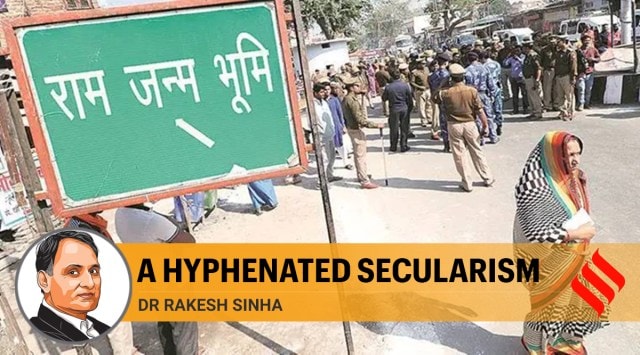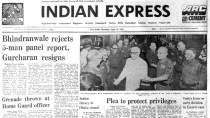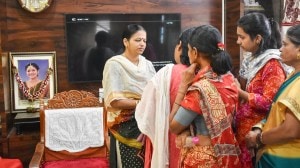- India
- International
Ram temple will free the discourse of secularism from elites
Modi has underpinned and rehabilitated “hyphenated secularism”. When the hegemonic idea mocks and bypasses the constituting ingredients of a culture, it inflicts moral injuries itself.
 The inheritors of the Nehruvian legacy of secularism declaim the unmitigated moral ownership by the state of the Ram temple as “majoritarianism”.
The inheritors of the Nehruvian legacy of secularism declaim the unmitigated moral ownership by the state of the Ram temple as “majoritarianism”. We have entered the 75th year of India’s hard-won independence. Ironically, the theme of secularism, which baffled the nation before 1947, is still subject to premeditated and illogical mystification, which camouflages a deeper understanding of the concept in the Indian context.
The construction of the Ram temple has once again brought the question centerstage: What constitutes Indian secularism? The opposing opinions on the bhoomi pujan at Ayodhya by Prime Minister Narendra Modi also expose a definitional deficit in the idea of secularism.
The inheritors of the Nehruvian legacy of secularism declaim the unmitigated moral ownership by the state of the Ram temple as “majoritarianism”. This is a hollow criticism and shows their understanding of the nation is a perpetuation of the colonial idea, which was logically contested by Rajendra Prasad, the then President of India, and many other well-known thinkers who had also been part of Nehru’s cabinet. Prasad’s inauguration of the Somnath temple on May 11, 1951, was appreciated by the Indian people.
The contexts of the Somnath and Ram temples are indistinguishable from each other. Secularism is embedded in India’s culture. Unfortunately, the quintessential question about the contours of a nuanced concept of Indian secularism revealed during the reconstruction of the Somnath temple remained unsettled due to the collective complacency of political elites and intellectuals. The reductionist understanding of the event led them to convert a battle of ideas into a clash of personalities — Nehru vs Prasad.
The pioneers of the Ram temple movement safeguarded it from being just another event or becoming individual-centric. The RSS-formulated perspective was well-articulated by Sarsanghachalak Mohan Bhagwat: “The Ram temple issue is far bigger than merely the construction of the temple.”

Nehru’s absence from the Somnath ceremony and Modi’s presence in Ayodhya represent two diametrically opposite views of secularism. While Nehru viewed the temple construction as an “act of revivalism”, Modi described the Ram temple as a “modern symbol of our culture”.
For Nehru, there was a singular narrative of secularism universally applicable to both India and the West. This narrative swallows inherent diversities in the practice of secularism. Some instances illustrate this. Secularism remains uninjured in America even though the US president takes oath on the Bible. It is a similar case with the legitimate shadow of the Church of England in British political life. In Indonesia, a Muslim-majority country, secularism has been exemplified by Hindu culture. And secular Turkey’s Islam remains uninjured despite the clerics in its 89,000 mosques reading speeches prepared by the Diyanet (Directorate of religious affairs). So, non-Hindu civilisations have used the melting-pot route to sustain secularism.
The Indian experience is different. Our cultural history, knowledge, traditions and faith in universal values collectively constitute the ethos of secularism. Unlike the melting-pot notion, our secularism is based on an unabated process of assimilation, free from the idea of otherness. This Indian exceptionalism remained suppressed, under colonial, and later under Euro-centric ideologies.
The colonial interpretation misconstrued the Hindu way of life as “Hinduism”. The intent was mischievous. A parallel with Semitic religions was crafted, undermining the inherent, undiluted, pluralistic creed in India. J H Hutton, the Census Commissioner of India in 1931, wrote that sharing the same belief is not a “compelling necessity” for Hindus. Another census commissioner, E A Gait, wrote in the 1911 census report that the tendency of Hindus was to “identify their neighbours, not according to their beliefs but according to their social status… No one is interested in what his neighbours believe”. The eight census reports in pre-independent India display a common understanding that Hindus internalised diversities of thought, modes of worships, philosophies and ways of living. They were surprised to find atheists and agnostics were also proud Hindus. Their findings were based on intensive and extensive empirical surveys and studies during enumerations. Nevertheless, they superimposed a Semitic definition on the Hindu way of life.
The Constituent Assembly thoughtfully endeavoured to undo the colonial construct of secularism. For instance, H C Mookerji, a Christian, and Tajamul Husain rejected the perpetuation of the concept of religious majority and minorities as detrimental to the idea of secularism. However, popular politics failed to unburden itself from colonial legacies. This vindicated Loknath Mishra’s prophetic warning in the Assembly that a secular state was a “slippery phrase” and might prove “a devise to bypass the ancient [Indian] culture”.
Modi’s speech during bhoomi pujan provided a wider canvas and context to the construction of the Ram temple. It reaffirms the commitment to Ramrajya, based on social justice and universal brotherhood. He aptly said, “Ram is a unifier and symbolises unity in diversities.” India can’t be imagined without its cultural and spiritual heritage, like, the Vedas, Upanishads, Mahabharata or icons like Ram, Mahavir, Buddha or Nanak. It has been an unbroken journey of multiple narratives.
Modi has underpinned and rehabilitated “hyphenated secularism”. When the hegemonic idea mocks and bypasses the constituting ingredients of a culture, it inflicts moral injuries itself. The first casualty is its capacity and rigour for a critical understanding of cultural and historical realities. The unhyphenated secularism of the Nehruvians tells the tale of their flawed and blinkered vision. The RSS philosophised constitutional secularism and it utilised the Ram temple to free the discourse on secularism from the elites. It worked with rigour and with intellectual, historical and empirical facts. Now, we have an opportunity to realise the strength of togetherness and shared values beyond the realm of binaries.
The writer is a BJP Rajya Sabha MP
EXPRESS OPINION
More Explained
Apr 26: Latest News
- 01
- 02
- 03
- 04
- 05











































